INDIAN ARMED FORCES CHIEFS ON
OUR RELENTLESS AND FOCUSED PUBLISHING EFFORTS

SP Guide Publications puts forth a well compiled articulation of issues, pursuits and accomplishments of the Indian Army, over the years

I am confident that SP Guide Publications would continue to inform, inspire and influence.

My compliments to SP Guide Publications for informative and credible reportage on contemporary aerospace issues over the past six decades.
Embraer’s Regional Jets — An Inspiring Journey
Embraer is reasonably hopeful that in the coming years the Indian aviation sector is likely to witness the inclusion of the 120-seater class E-Jet E2 jets on regional routes

During the ‘Wings India 2022’ exhibition at Hyderabad held in March 2022, Embraer showcased its largest, 146-seater commercial aircraft, the Embraer E195-E2. It was appreciated for its stunning look in the black and gold ‘TechLion’ livery that covered its fuselage and was touted by Embraer to be a major competitive alternative for the Indian regional aviation sector.
The Brazilian aerospace conglomerate Embraer headquartered in Sao Paulo, was founded in 1969 by the Government of Brazil. However, the company was privatised in 1994. It now has a team of 18,000 employees. Having delivered over 8,000 aircraft, Embraer is rated as the third largest producer of civil aircraft, next only to the global aerospace majors: Boeing of the United States (US) and the European Airbus. Embraer has overtaken rival regional aircraft makers such as Fairchild, Dornier, British Aerospace, De Havilland, Fokker and Saab. The primary competitor for Embraer in the regional jet category of aircraft is Bombardier of Canada. Today, Embraer has factories, offices and centers of distribution for parts and services in the US, Africa, Europe and the Asia-Pacific region including China.
THE INDIA CONNECTION
The Indian Air Force (IAF) has been one of the important customers of Embraer, operating four Embraer Legacy Business Jets (ERJ135) since 2005. Later, another aircraft was bought for use by the Border Security Force (BSF). Aerospace safety and operational record of this aircraft has been noteworthy. Besides these, the IAF also operates three Airborne Early Warning and Control (AEW&C) aircraft built on the Embraer’s ERJ145 regional jet airliner airframe and modified by integrating an airborne early warning radar and missile system.
COMMERCIAL AVIATION PRODUCT LINE UP
Embraer is structured under five verticals, viz the Commercial Aviation; Defence and Security; Executive Jets; Agriculture Aviation and Aeronautical Services and Support. This article covers the commercial aviation aspects. The three product lines offered by Embraer in commercial aviation are described below.
The Embraer Regional Jets (ERJ) family has three variants, ERJ135, ERJ140 and ERJ145. The ERJ145 was launched in 1989 as a turbofan-powered aircraft and it first flew on August 11, 1995. Its three versions had seating capacities up to 50 passengers, with ranges varying between 1,750 nautical miles to 2,000 nautical miles. After 1,231 aircraft being built, ERJ series production ended in 2020.
The largest aircraft in the E-Jet E2 family, the E195-E2 has been designed to maximise returns and efficiency on high-density routes
The Embraer E-Jet family was introduced in 1999, and entered production in 2002. It is a series of innovatively designed four-abreast seating, narrow-body, short-to-medium range twin-engine jet airliners. It boasts of a wide aisle, greater interior space and a larger baggage compartment than the existing mid-capacity jets of competitors. The E-Jets have turbofan engines designed to reduce noise, which allows them to operate in airports that have strict noise restrictions.
The Embraer E-Jets line is composed of two main commercial families. The smaller E170 and E175, with seating capacity between 66 to 88 passengers constitute the basic model. The E190 and E195 are stretched versions with seating capacity between 96 to 124 and have different engines, larger wing, horizontal stabilisers and different landing gear structures. The two families share approximately 89 per cent commonality with identical fuselage cross-sections and avionics, featuring the Honeywell Primus Epic Electronic Flight Instrument System (EFIS) suite. This series claims to have ten percent reduction in fuel burn as compared to its contemporaries and 25 per cent better fuel efficiency per seat.
To date, Embraer has delivered 1,621 E-Jet aircraft and another 170 are in the pipeline. This version is known to be operated by 80 airlines worldwide, having flown close to 30 million flight hours. The series has been a commercial success primarily due to its ability to efficiently serve lower-demand routes while offering many of the amenities and features offered by larger jets. The E-Jet family is used by mainline and regional airlines around the world as a feeder to main routes or dedicated to provide connectivity to smaller metro cities. They are particularly popular with regional airlines in the US, Europe, Brazil, Japan, Russia and even China that operates 51 of these aircraft.
EMBRAER E-JET E2 SERIES- PROFIT HUNTERS
The Embraer E-Jet E2 family are medium-range jet airliners, succeeding the original E-Jet. The programme was launched in 2013. The first variant, the E190-E2, undertook its first flight on May 23, 2016, and entered service on April 24, 2018. It has three variants, viz E175-E2, E190-E2 and E195-E2. All these twin-jet have the same four-abreast seating in narrow-body fuselage with different lengths and three different new wings, Pratt & Whitney PW1000G turbofan engines, fly-by-wire controls with new avionics and an updated cabin.
EMBRAER COMMERCIAL AVIATION — FROM INCEPTION TILL NOW
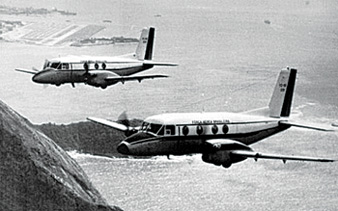 | 1969October 19, 1969: Embraer’s first production aircraft. The Bandeirante turboprop takes to the air for its inaugural flight |
1989September 28, 1989: Embraer’s first turbofan-powered aircraft The Embraer ERJ-145 is launched at the Paris Airshow | 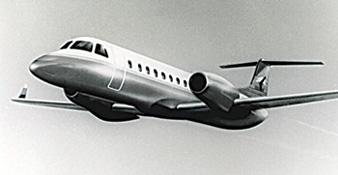 |
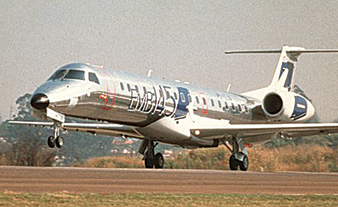 | 1995August 11, 1995: First flight of the Embraer ERJ-145 |
1999June 14, 1999: EMBRAER 170/190 regional jets launched with seating capacity for between 70 and 118 passengers | 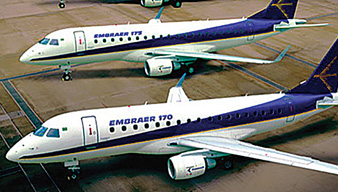 |
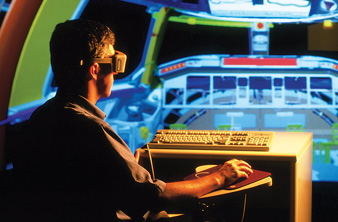 | 2000February 23, 2000: Embraer opens the Virtual Reality Center (CSRC ) revolutionising design and development |
2011November 11, 2011: The secondgeneration E-Jet E2 is announced powered by new, more efficient engines and incorporating a new wing design |  |
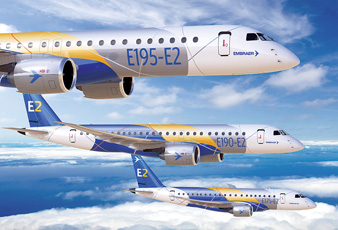 | 2013June 17, 2013: Embraer announces the launch of Ejets E2 and comprising three new airplanes: E175-E2, E190-E2 and E195-E2 |
2015April 15, 2015: E-Jets E2 cabin interior concept receives prestigious Crystal Cabin Award in the "Industrial Design and Visionary Concepts" category for outstanding innovation. | 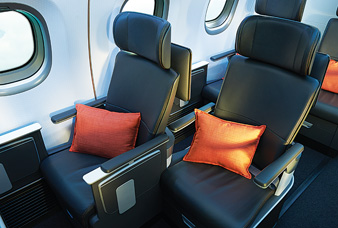 |
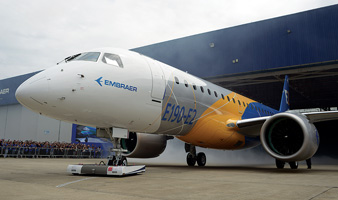 | 2016January 1, 2016: Embraer rolls out the first member of the second generation E-Jet family, the E190 E2 |
2017January 4, 2017: The ERJ145 ‘Runway Legend’ celebrates 20 years of commercial service | 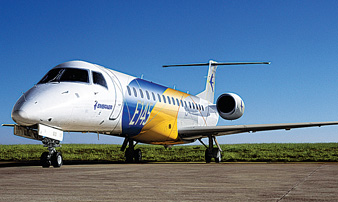 |
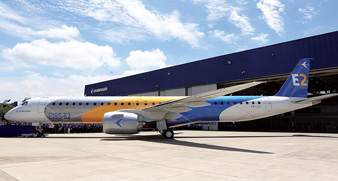 | 2017March 28, 2017: Rollout of the next-generation E195-E2, the most efficient next-generation commercial jet in the world |
Source: Embraer Commercial Aviation
Embraer claims that its new-generation aircraft design translates into significant improvements in maintenance costs. E-Jets deliver from ten to 20 per cent lower hourly maintenance costs compared to other similar-capacity aircraft and more than 50 per cent lower cost than some outof- production jets. The largest aircraft in the E-Jet E2 family, the E195-E2 has been designed to maximise returns and efficiency on high-density routes. With its high-aspect ratio wings and swept wings, combined with other aero-dynamic improvements, the E195-E2 achieves double digit lower fuel consumption compared to current-generation E-Jets. Also, like the E-Jet, it claims 65 per cent noise reduction.
EMBRAER’S STRATEGY FOR REGIONAL CONNECTIVITY IN INDIA
Embraer eyes big opportunity in Indian Regional Connectivity Scheme (RCS) - Ude Deshka Aam Nagrik (UDAN) scheme. Francisco Gomes Neto, President & CEO, Embraer, told the Financial Express Online in April 2022 that, regional jets such as E-Jets and E-Jets E2 are the perfect fit for India to bring more connectivity to the country. He mentioned that the E195-E2 offers low-cost per-seat, making it very competitive in comparison to the large narrowbody aircraft that are presently flying on regional routes in India. He brought out that, even before the onset of the COVID-19 pandemic, 50 per cent of domestic flights in India had from 90 to 150 passengers per flight.
Raul Villaron, Vice President Asia Pacific, Embraer, in an interview with Simple Flying said, “Airlines like IndiGo, SpiceJet and GoAir have started adding new routes to and from smaller cities. However, airlines faced an issue on these regional routes. While some had enough traffic for either turboprops such as the Q400 or ATR72 or narrow bodies like the A320 or 737, several routes were found themselves in between these categories.” Embraer’s strategy in India involves the concept of ‘hub bypass’ or bypassing the traditional hub-spoke concept, for essentially serving Tier-2 and Tier-3 cities by direct connectivity. He said, “As more regional routes attract greater traffic, airlines will have to consider investing in regional jets. This is where aircraft like the Embraer E2 fits in perfectly. With seating for 100 to 120 passengers, the E190 or E195 will suitably serve these routes. The combination of right capacity and right unit cost makes the E-Jets a compelling case to connect metro to non-metro and non-metro to metro cities in the Indian domestic market.”
EMBRAER FREIGHTERS IN THE PIPELINE
On March 7, 2022, Embraer revealed that taking cognizance of phenomenal growth in e-commerce and increased demand for cargo capacity, especially in smaller markets, it intends to convert its pre-owned E-190s and E-195s to freighters. Embraer’s strategy is based on rightsizing by exploiting the gap between turboprop and larger narrow-body freighters. The E-Jet Freighters will have over 50 per cent more volumetric capacity, three times the range of large cargo turboprops and up to 30 per cent lower operating costs than narrow bodies. Its freighters will have a payload of 10,700 kg and 12,300 kg respectively. These will have to undergo structural modifications and first deliveries are planned in 2024.
TURBOPROP VERSION
Francisco Gomes Neto, President & CEO, Embraer, has stated that Embraer is working on a new turboprop concept which is to bring to the regional aviation market, a new aircraft that could be more fuel-efficient with upgraded passenger experience and green credentials. He said that it would offer the least fuel burn, lowest emissions, minimal airport noise footprint and lowest trip and seat cost solution for current turboprop routes. Additionally, it would also deliver a jet-like experience to the customer including airport bridge capability, lower noise, less vibration, more personal space, more cabin baggage space, proper galleys and lavatories. He further mentioned that Embraer is currently in discussions with suppliers and possible partners and for sure, India is a great potential market.
THE FUTURE
Embraer is reasonably hopeful that in the coming few years Indian aviation sector is likely to witness inclusion of the 120-seater class E-Jet E2 jets on regional routes and maybe, a newer turboprop also. Currently, only one Indian regional airline, Bengaluru-based Star Air owned by Sanjay Ghodawat, with its five ERJ145 aircraft operates to 17 destinations. However, the future could hold better opportunities. There has also been some talk of Indian regional airline TruJet, a Hyderabad-based airlines, procuring a substantial number of regional jets from Embraer, subject to additional fund flows.





